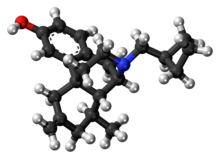 | |
 | |
| Clinical data | |
|---|---|
| ATC code |
|
| Identifiers | |
| |
| CAS Number | |
| PubChem CID | |
| ChemSpider | |
| UNII | |
| Chemical and physical data | |
| Formula | C23H31NO |
| Molar mass | 337.507 g·mol−1 |
| 3D model (JSmol) | |
| |
| |
| | |
Xorphanol (INN) (developmental code name TR-5379 or TR-5379M), also known as xorphanol mesylate (USAN), is an opioid analgesic of the morphinan family that was never marketed.[1][2][3]
Xorphanol is a mixed agonist–antagonist of opioid receptors,[4][5][6] acting preferentially as a high-efficacy partial agonist/near-full agonist of the κ-opioid receptor (Ki = 0.4 nM; EC50 = 3.3 nM; Imax = 49%; IA = 0.84)[7][8][9] and to a lesser extent as a partial agonist of the μ-opioid receptor (Ki = 0.25 nM; IC50 = 3.4 nM; Imax = 29%) with lower relative intrinsic activity and marked antagonistic potential (including the ability to antagonize morphine-induced effects and induce opioid withdrawal in opioid-dependent individuals).[3][10] The drug has also been found to act as an agonist of the δ-opioid receptor (Ki = 1.0 nM; IC50 = 8 nM; Imax = 76%).[11]
Xorphanol produces potent analgesia, and was originally claimed to possess a minimal potential for dependence or abuse.[12][13][14] Moreover, side effects in animal studies were relatively mild, with only sedation and nausea being prominent, although it also produced convulsions at the highest dose tested.[15] However, human trials revealed additional side effects such as headaches and euphoria, and this was the subject of a lawsuit between the drug's inventors and the company to which they had licensed the marketing rights, which claimed that these side effects had not been revealed to them during the license negotiations.[16] As a result of this dispute, the drug was never marketed commercially.
YouTube Encyclopedic
-
1/1Views:82 431
-
How Do Cough Drops Work
Transcription
See also
- 6-Methylenedihydrodesoxymorphine
- Butorphanol
- Cyclorphan
- Ketorfanol
- Levallorphan
- Levomethorphan
- Levorphanol
- Nalmefene
- Nalbuphine
- Nalorphine
- Oxilorphan
- Proxorphan
References
- ^ Morton IK, Hall JM (31 October 1999). Concise Dictionary of Pharmacological Agents: Properties and Synonyms. Springer Science & Business Media. pp. 294–. ISBN 978-0-7514-0499-9.
- ^ Evans SM, Lenz GR, Lessor RA (January 1990). "Analgesics". Annual Reports in Medicinal Chemistry. Academic Press. 25: 11–20 (12). ISBN 978-0-08-058369-3.
- ^ a b Lednicer D (25 June 1990). The Organic Chemistry of Drug Synthesis. Wiley. p. 61. ISBN 978-0-471-85548-4.
- ^ Colbern DL, Gispen WH (1 January 1988). Neural Mechanisms and Biological Significance of Grooming Behavior. New York Academy of Sciences. ISBN 978-0-89766-441-7.
- ^ Gmerek DE, Cowan A (1988). "Role of opioid receptors in bombesin-induced grooming" (PDF). Annals of the New York Academy of Sciences. 525 (1 Neural Mechan): 291–300. Bibcode:1988NYASA.525..291G. doi:10.1111/j.1749-6632.1988.tb38614.x. hdl:2027.42/73648. PMID 2839069. S2CID 31977725.
- ^ Cowan A, Zhu XZ, Mosberg HI, Porreca F (1986). "Central infusion of rats with agents selective for different types of opioid receptor". NIDA Research Monograph. 67: 132–7. PMID 3018570.
- ^ Gharagozlou P, Hashemi E, DeLorey TM, Clark JD, Lameh J (January 2006). "Pharmacological profiles of opioid ligands at kappa opioid receptors". BMC Pharmacology. 6 (1): 3. doi:10.1186/1471-2210-6-3. PMC 1403760. PMID 16433932.
- ^ Bernard Testa (22 October 2013). Advances in Drug Research. Elsevier. pp. 245–. ISBN 978-1-4832-8798-0.
- ^ Gharagozlou P, Demirci H, David Clark J, Lameh J (January 2003). "Activity of opioid ligands in cells expressing cloned mu opioid receptors". BMC Pharmacology. 3: 1. doi:10.1186/1471-2210-3-1. PMC 140036. PMID 12513698.
- ^ Dr. S. S. Kadam (1 July 2007). PRINCIPLES OF MEDICINAL CHEMISTRY Vol. - II. Pragati Books Pvt. Ltd. pp. 214–. ISBN 978-81-85790-03-9.
- ^ Gharagozlou P, Demirci H, Clark JD, Lameh J (November 2002). "Activation profiles of opioid ligands in HEK cells expressing delta opioid receptors". BMC Neuroscience. 3 (1): 19. doi:10.1186/1471-2202-3-19. PMC 137588. PMID 12437765.
- ^ Polazzi JO, Kotick MP, Howes JF, Bousquet AR (December 1981). "Analgesic narcotic antagonists. 9. 6-Methylene-8 beta-alkyl-N-(cycloalkylmethyl)-3-hydroxy- or -methoxymorphinans". Journal of Medicinal Chemistry. 24 (12): 1516–8. doi:10.1021/jm00144a029. PMID 6796691.
- ^ McCarthy PS, Howlett GJ (December 1984). "Physical dependence induced by opiate partial agonists in the rat". Neuropeptides. 5 (1–3): 11–4. doi:10.1016/0143-4179(84)90014-3. PMID 6152317. S2CID 31842402.
- ^ Howes JF, Villarreal JE, Harris LS, Essigmann EM, Cowan A (February 1985). "Xorphanol". Drug and Alcohol Dependence. 14 (3–4): 373–80. doi:10.1016/0376-8716(85)90068-7. PMID 4039650.
- ^ Porter MC, Hartnagel RE, Clemens GR, Kowalski RL, Bare JJ, Halliwell WE, Kitchen DN (1983). "Preclinical toxicity and teratogenicity studies with the narcotic antagonist analgesic drug TR5379M". Fundamental and Applied Toxicology. 3 (5): 478–82. doi:10.1016/S0272-0590(83)80023-2. PMID 6642105.
- ^ Maruho Company Ltd v Miles Inc (1993) 13 F.3d 6
